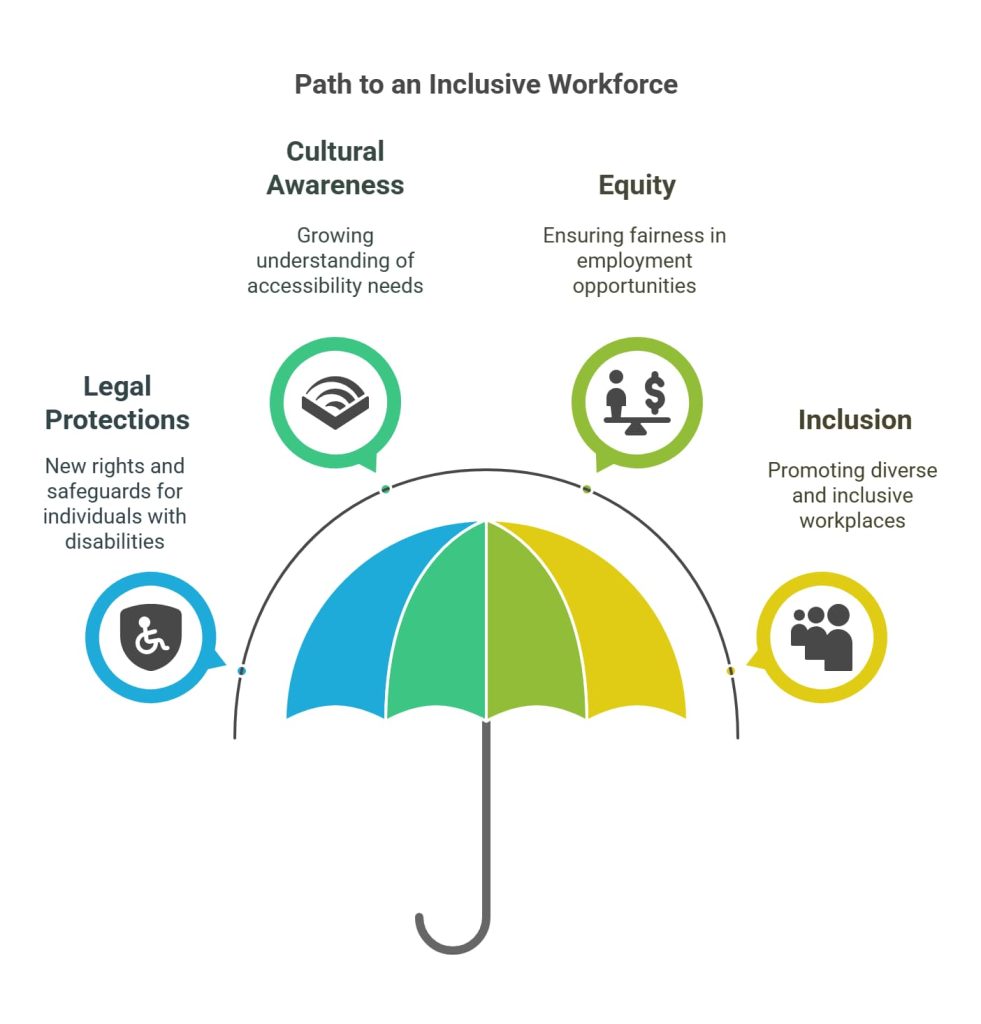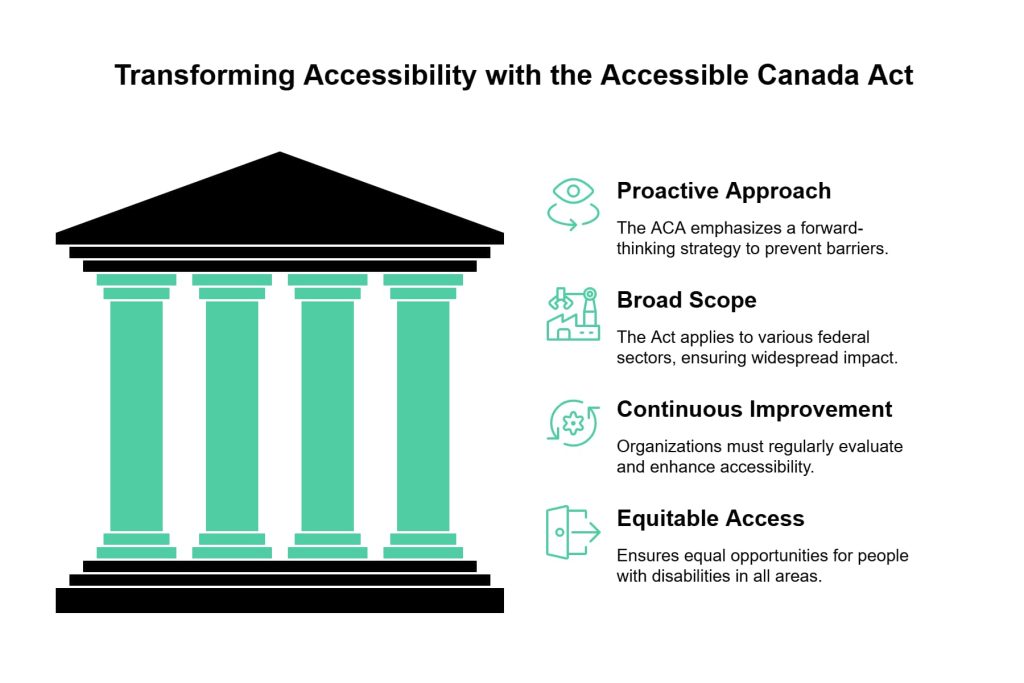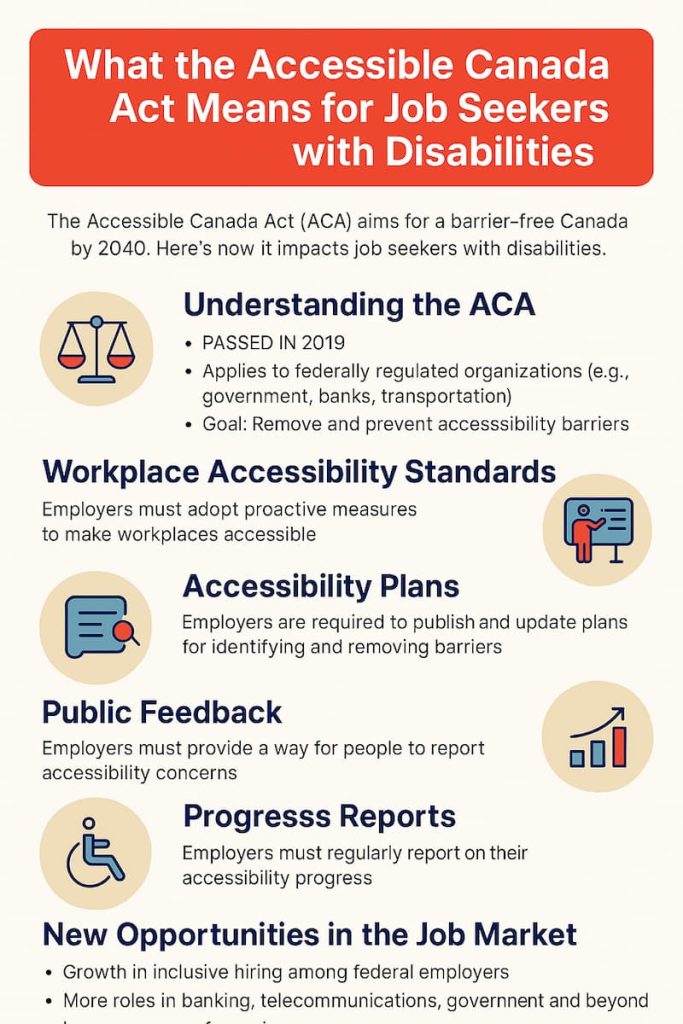For many Canadians living with disabilities, the search for meaningful employment has long been impacted by structural barriers—ranging from inaccessible workplaces to unconscious bias during the hiring process. Fortunately, progress is being made, and at the heart of that progress is a transformative piece of legislation: the Accessible Canada Act (ACA).
Enacted in 2019, the ACA is designed to shift Canada toward becoming a barrier-free society by the year 2040. For job seekers with disabilities, this legislation represents not only new legal protections but also an evolving cultural awareness of the need for accessibility, equity, and inclusion in the workforce. If you’re navigating the job market or planning your next career move, understanding how the ACA applies to you can be both empowering and practically helpful.
Understanding the Accessible Canada Act
The Accessible Canada Act is federal legislation that aims to proactively eliminate and prevent barriers that hinder the full participation of persons with disabilities in society. Unlike past policies that focused primarily on responding to discrimination after it occurred, the ACA takes a forward-thinking, systemic approach. It requires federally regulated organizations to build accessibility into their operations, culture, and physical and digital environments.
The scope of the ACA is broad. It applies to federal government departments and agencies, as well as private sector employers in federally regulated industries such as banking, telecommunications, interprovincial transportation, and postal services. These organizations are expected to adopt a continuous cycle of evaluating and improving accessibility. The ACA’s central promise is to ensure that people with disabilities have equitable access not just to employment, but also to the services, infrastructure, and technologies that shape everyday life.
How the ACA Impacts Job Seekers with Disabilities
For job seekers, the most immediate and meaningful impact of the ACA is felt in the employment sector. Under this law, employers covered by the Act are required to create work environments where accessibility is embedded from the start. This includes everything from removing physical barriers in office spaces to redesigning hiring practices that may unintentionally exclude individuals with certain disabilities.
One of the ACA’s core requirements is that employers must develop and publish detailed accessibility plans. These plans are not optional—they are legal obligations that must outline how an organization is identifying and addressing barriers to accessibility within their workplace. For job seekers, this means that you now have a transparent way to assess how committed a potential employer is to inclusion and accessibility.
In addition, organizations must establish a feedback mechanism that allows employees, job applicants, and the general public to share accessibility-related concerns or suggestions. These employers must also report regularly on their progress. The presence of these tools makes it possible for you, as a job seeker, to contribute directly to shaping more accessible workplaces while holding employers accountable.
Creating Opportunity Through Compliance
Beyond legal compliance, the ACA is influencing a cultural shift among employers. Increasingly, organizations are recognizing that creating an accessible workplace is not just a regulatory checkbox—it’s a strategy that benefits everyone. From improved workplace morale to attracting diverse talent, companies are beginning to see inclusion as an asset, not an obligation.
This changing perspective is gradually expanding the range and quality of job opportunities available to people with disabilities. As awareness grows, federally regulated employers are adopting inclusive job descriptions, offering alternative formats for applications, conducting bias-free interviews, and integrating assistive technologies into the workplace. These developments are helping to ensure that candidates are evaluated based on their skills, not their limitations.
Job seekers today may find that positions which were once inaccessible or unwelcoming are now actively seeking applicants with lived experience of disability. The ACA helps to ensure that when these opportunities arise, they are supported by systems that make participation possible, practical, and sustainable.
Knowing Your Rights in the Hiring Process
One of the most empowering aspects of the ACA is that it provides job seekers with specific rights during the application and hiring process. For example, you have the right to request reasonable accommodations during an interview—whether that means access to a sign language interpreter, extended time for assessments, or an alternative communication method.
Employers cannot discriminate against you for disclosing a disability or asking for support. In fact, the ACA mandates that federally regulated employers must take proactive steps to ensure that their hiring practices are accessible by default. If you encounter a barrier during your job search—for instance, an inaccessible online application form or a lack of accommodations during the interview—you have the right to report it to enforcement bodies such as the Canadian Human Rights Commission or the Accessibility Commissioner.
By knowing your rights, you’re better positioned to advocate for yourself and ensure that your skills and qualifications are what define your candidacy—not your disability status.
What to Look for When Applying to ACA-Covered Employers
If you’re applying for jobs within federally regulated organizations, you now have more tools to assess how accessible and inclusive an employer truly is. Begin by reviewing their publicly available accessibility plan, which should be easy to find on their website. These plans will offer insight into how the organization is addressing barriers, implementing staff training, updating technologies, and engaging with employees with disabilities.
You can also review their most recent accessibility progress reports to evaluate how seriously they are taking their commitments. Are they making concrete changes year over year? Are they transparent about their challenges and successes? This information can help you identify workplaces that are not only legally compliant, but genuinely invested in long-term accessibility.
The Bigger Picture: Moving Toward an Inclusive Future
Although the ACA applies only to federally regulated sectors for now, its impact is broader than it appears. As accessibility becomes part of the national conversation, employers outside federal jurisdiction are beginning to adopt similar practices voluntarily. This ripple effect is slowly but steadily transforming Canada’s employment landscape into one where people of all abilities have the right to contribute and thrive.
There is still work to be done. Many private sector businesses, especially small and medium enterprises, are not yet covered by the ACA and may lack the resources or knowledge to implement best practices. However, the Act sets a standard that can influence policies, behaviors, and expectations across the entire country.
The Accessible Canada Act marks a powerful shift in how our society views and addresses disability in the workplace. For job seekers, it brings greater transparency, stronger protections, and a growing culture of inclusion. It places legal and moral responsibility on employers to create environments where everyone, regardless of ability, has a fair and equal chance to succeed. Organizations like BT Family Services are leading by example, offering accessible employment support and helping individuals connect with inclusive job opportunities. If you’re navigating your career path, know that you are not alone—and that you now have more tools, rights, and opportunities than ever before to thrive in a more inclusive workforce.
Frequently Asked Questions (FAQs)
1. What is the Accessible Canada Act (ACA)?
The ACA is a federal law passed in 2019 that aims to make Canada barrier-free by 2040. It requires federally regulated organizations to identify, remove, and prevent accessibility barriers in areas like employment, transportation, and information.
2. Who does the ACA apply to?
The ACA applies to organizations under federal jurisdiction, including government departments, banks, telecom companies, interprovincial transportation providers, and Crown corporations.
3. How does the ACA support job seekers with disabilities?
It requires employers to create accessibility plans, establish feedback mechanisms, and report on their progress, all aimed at creating more inclusive and accessible work environments.
4. Do employers have to accommodate job applicants with disabilities?
Yes. Under the ACA and related human rights laws, federally regulated employers must provide reasonable accommodations during the hiring process and on the job.
5. How can I find out if an employer is ACA-compliant?
You can visit their website to read their published accessibility plans and progress reports. These documents are required and should be publicly available.
6. What should I do if I face discrimination during hiring?
You can file a complaint with the Canadian Human Rights Commission or report the issue to the Accessibility Commissioner, depending on the nature of the barrier.
7. Does the ACA apply to private companies?
Only federally regulated private companies are required to comply with the ACA. However, many other businesses are voluntarily adopting its principles.
8. What kind of accommodations can I request during the hiring process?
You can request various supports, including alternative communication formats, assistive technologies, sign language interpreters, or modified assessments.
9. How often do employers have to update their accessibility plans?
At least every three years. They must also report regularly on the progress they are making toward removing identified barriers.
10. What is the long-term goal of the ACA?
To create a Canada that is fully accessible by 2040—where people with disabilities can participate fully and equally in every aspect of society, including employment.








